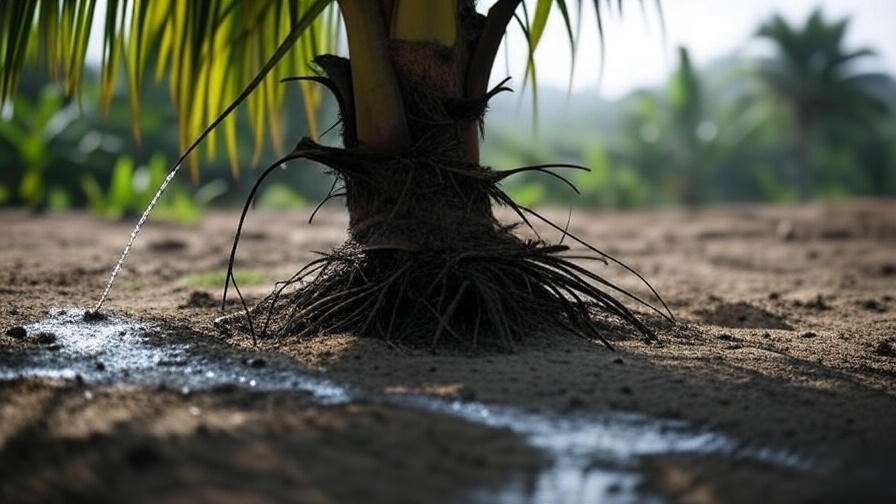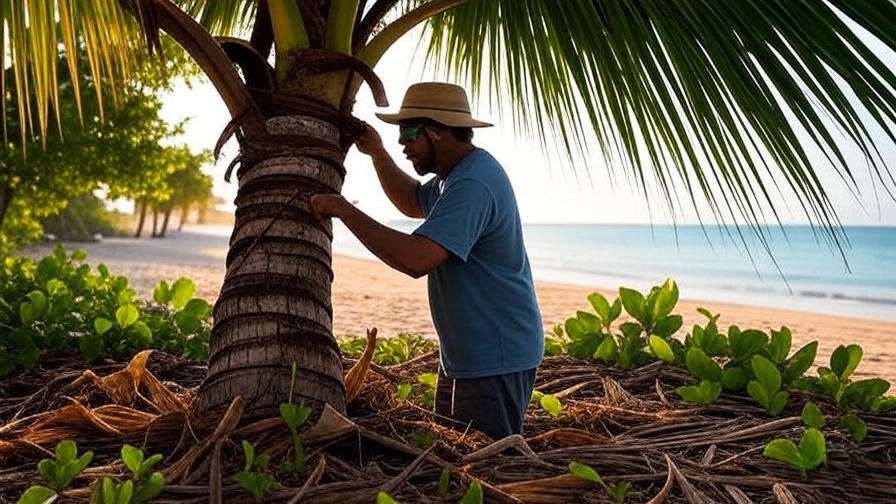Picture this: a lush, tropical paradise with towering coconut trees swaying in the breeze, their vibrant fronds shading golden beaches. At the core of these iconic palms lies the coconut tree heart—the tender, life-giving terminal bud that holds the key to their health and longevity. Whether you’re a seasoned gardener, a tropical homeowner, or a plant enthusiast, understanding how to care for the coconut tree heart is essential for growing thriving palms that produce abundant coconuts. In this comprehensive guide, I’ll share expert-backed strategies to nurture this vital part, ensuring your coconut trees flourish for years to come. As a tropical horticulturist with over a decade of experience, I’ve seen firsthand how proper care transforms struggling palms into vibrant giants. Let’s dive into the secrets of coconut tree heart care! 🌞
H2: What Is the Coconut Tree Heart? 🥥
H3: Understanding the Anatomy of a Coconut Tree
The coconut tree heart, also known as the terminal bud or apical meristem, is the soft, central core at the top of the palm where new growth emerges. This delicate tissue is responsible for producing new fronds, flowers, and, ultimately, coconuts. According to Dr. Maria Lopez, a tropical botanist with 15 years of research in palm cultivation, “The heart is the engine of the coconut tree—damage it, and the entire tree suffers.” Located just below the crown of fronds, the heart is both the growth hub and the most vulnerable part of the palm.
Coconut trees (Cocos nucifera) are monocots, meaning they lack the secondary growth found in woody trees. Instead, their single growing point—the heart—drives all upward and outward development. A healthy heart ensures robust fronds, strong flowering, and high-quality coconut production, making it a focal point for growers aiming for both aesthetic and productive palms.

H3: Why the Coconut Tree Heart Is Vulnerable
The coconut tree heart is susceptible to a range of threats, including pests, diseases, and improper harvesting practices. Its soft, succulent tissue attracts insects like the red palm weevil, while fungal infections like bud rot can devastate it. Human activities, such as overzealous pruning or unsustainable heart-of-palm harvesting, can also cause irreversible damage. For example, removing the heart for culinary use (often called “millionaire’s salad”) typically kills the tree, as it cannot regenerate this critical growth point. Understanding these vulnerabilities is the first step to protecting your palms and ensuring their long-term health.
H2: The Importance of Caring for the Coconut Tree Heart 🌞
H3: Benefits of a Healthy Coconut Tree Heart
A well-maintained coconut tree heart delivers a cascade of benefits:
- Longevity: A healthy heart supports a tree’s ability to live for 60–100 years.
- Productivity: Robust hearts lead to higher coconut yields, with mature trees producing up to 75 nuts annually.
- Aesthetic Appeal: Vibrant, green fronds enhance the tropical charm of landscapes, perfect for homes or resorts.
- Resilience: Strong hearts help palms withstand environmental stresses like drought or storms.
For commercial growers, a thriving heart translates to better profits, while home gardeners enjoy the beauty and bounty of their palms.
H3: Common Problems if Neglected
Neglecting the coconut tree heart can spell disaster. Symptoms of an unhealthy heart include yellowing or browning fronds, stunted growth, and reduced coconut production. In severe cases, bud rot or pest infestations can kill the tree. For instance, a coconut grove in海南, China, suffered a 40% loss due to untreated red palm weevil infestations in 2023. Recovery involved intensive pest management and nutrient supplementation, underscoring the importance of proactive care. By addressing issues early, you can prevent costly losses and keep your palms thriving.
H2: Essential Care Tips for a Thriving Coconut Tree Heart 🌱
H3: Proper Watering Techniques 💧
Watering is critical for coconut tree heart health, as the terminal bud relies on consistent moisture to fuel growth. In tropical climates, aim for 40–50 liters of water per tree weekly, adjusting for rainfall. Young trees need more frequent watering (every 2–3 days), while mature palms can tolerate longer intervals. Use drip irrigation or soaker hoses to deliver water directly to the root zone, avoiding waterlogging, which can suffocate roots and stress the heart.
Tip: Invest in a moisture meter to monitor soil conditions, ensuring the soil remains moist but not soggy. Overwatering can lead to fungal infections, a leading cause of heart damage.

H3: Nutrient Management for Optimal Growth 🍃
Coconut trees are heavy feeders, and the heart requires a steady supply of nutrients to thrive. Apply a balanced fertilizer with high potassium content (e.g., NPK 10-10-20) every 3–4 months. Potassium strengthens the heart and fronds, while magnesium and boron prevent deficiencies that cause yellowing or weak growth. For young trees, use a slow-release fertilizer to promote steady development, while mature trees benefit from granular applications spread evenly around the root zone.
Expert Tip: Conduct a soil test annually to tailor your fertilizer plan. Coastal soils, common for coconut cultivation, often lack micronutrients, so supplements like Epsom salts (magnesium sulfate) can make a big difference.
H3: Protecting the Heart from Pests and Diseases 🐞
The coconut tree heart faces constant threats from pests and pathogens. The red palm weevil (Rhynchophorus ferrugineus) is a notorious culprit, burrowing into the heart and laying eggs that destroy tissue. Bud rot, caused by fungi like Phytophthora palmivora, thrives in humid conditions and can rot the heart from within. To protect your palms:
- Monitor Regularly: Inspect the heart monthly for signs of damage, such as holes, oozing sap, or foul odors.
- Use Organic Controls: Apply neem oil or beneficial nematodes to deter pests naturally.
- Chemical Options: For severe infestations, consult a local agricultural extension for approved insecticides or fungicides.
Case Study: A plantation in Kerala, India, reduced weevil damage by 80% using pheromone traps and regular inspections, proving the value of proactive pest management.

H3: Pruning and Maintenance Best Practices ✂️
Pruning coconut trees requires precision to avoid harming the heart. Remove only dead or yellowing fronds, as over-pruning stresses the tree and exposes the heart to pests and sun damage. Use clean, sharp tools to make smooth cuts, and prune during the dry season to minimize fungal risks.
Warning: Never cut into the green, healthy fronds near the heart, as this can disrupt growth. For tall trees, hire a professional arborist to ensure safe and accurate pruning.

H3: Harvesting the Heart Sustainably 🌴
Harvesting the coconut tree heart for culinary use is a delicate process, as it typically kills the tree. To enjoy heart of palm sustainably:
- Choose Young Trees: Harvest from secondary or non-productive palms to preserve mature, fruit-bearing trees.
- Minimize Damage: Use sterile tools and cut only the terminal bud, avoiding unnecessary harm to surrounding tissue.
- Plant Replacements: For every harvested tree, plant a new coconut seedling to maintain your grove.
Alternative: Consider growing multi-stemmed palms like the “Malayan Dwarf” variety, which can tolerate limited heart harvesting without dying.
H2: Environmental Factors Affecting the Coconut Tree Heart ☀️
H3: Ideal Climate and Soil Conditions
The coconut tree heart thrives in warm, humid environments typical of tropical and subtropical regions. Ideal conditions include:
- Temperature: 25–32°C (77–90°F), with minimal fluctuations. Prolonged exposure to temperatures below 15°C (59°F) can slow heart growth and weaken the tree.
- Humidity: 70–80% relative humidity supports healthy frond and heart development.
- Soil: Well-draining, sandy loam with a pH of 5.5–7.0 is optimal. Coconut trees tolerate saline soils but require good drainage to prevent root rot, which indirectly stresses the heart.
To optimize soil conditions, amend heavy clay soils with organic matter like compost or coconut coir. Regular soil testing ensures nutrient availability, as deficiencies in potassium or magnesium can stunt heart growth. For coastal growers, incorporate gypsum to reduce soil salinity and improve heart health.
H3: Managing Extreme Weather
Coconut trees are resilient but vulnerable to extreme weather, which can damage the heart. Here’s how to protect your palms:
- Storms and High Winds: Strong winds can snap fronds or expose the heart to debris. Install windbreaks, such as native shrubs or bamboo fencing, around young trees. For mature palms, ensure proper spacing (8–10 meters apart) to reduce wind stress.
- Drought: Prolonged dry spells dehydrate the heart, leading to wilting fronds. Mulch around the base with organic materials like wood chips or palm fronds to retain soil moisture. Supplement with deep watering during dry periods.
- Heavy Rain: Excessive moisture increases the risk of bud rot. Ensure proper drainage by planting on slightly raised mounds in flood-prone areas.
Practical Solution: For young trees, use stakes or guy wires to stabilize them during storms, but remove them after 2–3 years to avoid restricting growth.
H2: Advanced Care Techniques for Expert Growers 🌟
H3: Monitoring Tree Health with Technology
Modern technology can revolutionize coconut tree heart care, especially for commercial growers. Drones equipped with multispectral cameras can assess canopy health, detecting early signs of heart stress, such as nutrient deficiencies or pest damage. Mobile apps like Plantix or AgriApp allow growers to upload photos of the heart or fronds for AI-driven diagnostics, providing real-time recommendations.
Example: A coconut plantation in the Philippines used drone surveillance to identify bud rot in 10% of its trees, enabling targeted treatment that saved 95% of the affected palms. By integrating technology, growers can catch issues before they escalate, ensuring healthier hearts and higher yields.

H3: Grafting and Propagation for Stronger Trees
Propagation techniques can enhance coconut tree heart resilience. While coconut trees are typically grown from seed, grafting hybrid varieties like the “Malayan Dwarf” or “Fiji Dwarf” onto robust rootstocks can produce palms with stronger hearts and better disease resistance. These hybrids are less prone to lethal yellowing, a devastating disease that targets the heart.
Expert Insight: Dr. Anil Kumar, a palm propagation specialist, notes, “Hybrid coconut varieties offer a 20–30% higher survival rate in pest-prone regions due to their vigorous hearts.” To propagate:
- Select a healthy, disease-free seed nut from a high-yielding parent tree.
- Germinate in a nursery with well-draining soil and partial shade.
- Transplant seedlings after 6–9 months, ensuring the heart is protected from direct sun.
For advanced growers, tissue culture techniques are emerging as a way to produce uniform, disease-resistant coconut trees, though this requires specialized facilities.
H2: Troubleshooting Common Coconut Tree Heart Issues 🔍
H3: Signs of an Unhealthy Heart
An unhealthy coconut tree heart manifests through visible symptoms. Watch for:
- Yellowing or Browning Fronds: Indicates nutrient deficiency or pest damage.
- Soft or Discolored Heart Tissue: Suggests bud rot or fungal infection.
- Foul Odors or Oozing Sap: Signals internal decay, often from weevils or bacteria.
- Stunted Growth: Slow frond production or small coconuts point to heart stress.
Diagnostic Checklist:
- Inspect the heart for physical damage or pest activity.
- Check soil moisture and nutrient levels with a soil test kit.
- Look for insect frass (droppings) or fungal growth near the crown.
- Monitor frond color and growth rate over 2–3 weeks.
H3: Solutions for Recovery
Addressing heart issues promptly can save your tree. Here’s how:
- Pest Infestations: For red palm weevils, apply pheromone traps and inject approved insecticides into the heart under professional guidance. Neem oil sprays deter smaller pests.
- Nutrient Deficiencies: Correct magnesium or potassium shortages with foliar sprays or soil amendments. Reapply every 6–8 weeks until fronds regain their green color.
- Fungal Infections: Remove affected tissue with sterile tools and apply copper-based fungicides. Improve air circulation by spacing trees properly.
- When to Consult an Expert: If the heart shows extensive rot or the tree fails to recover after 1–2 months, contact a certified arborist or local agricultural extension service.
H2: FAQs About Coconut Tree Heart Care ❓
Q1: Can a coconut tree survive if the heart is damaged?
A: Minor damage may allow recovery with proper care, but severe damage (e.g., complete heart removal) usually kills the tree, as it cannot regenerate its terminal bud. Early intervention is critical.
Q2: How often should I check the heart for pests?
A: Inspect monthly during the wet season and every 2 months during dry periods. Regular checks catch issues like weevil infestations early.
Q3: Is heart of palm harvesting ethical?
A: Harvesting is ethical if done sustainably, such as targeting non-productive trees or using multi-stemmed varieties. Always replant to maintain grove health.
Q4: What’s the best fertilizer for coconut tree heart health?
A: A potassium-rich fertilizer (e.g., NPK 10-10-20) with added magnesium and boron works best. Apply every 3–4 months based on soil test results.
Q5: How can I tell if my coconut tree is thriving?
A: Look for glossy green fronds, steady frond production (1–2 per month), and consistent coconut yields. A firm, healthy heart with no discoloration is a good sign.
H2: Conclusion: Grow Vibrant Coconut Trees with Confidence 🌴
Caring for the coconut tree heart is the cornerstone of growing lush, productive palms that enhance your landscape and yield delicious coconuts. By following these expert tips—proper watering, nutrient management, pest control, and sustainable practices—you can ensure your coconut trees thrive for decades. Start implementing these strategies today, and watch your palms transform into tropical masterpieces! Share your coconut tree care journey in the comments or explore our other plant care guides for more tips. 🌟













